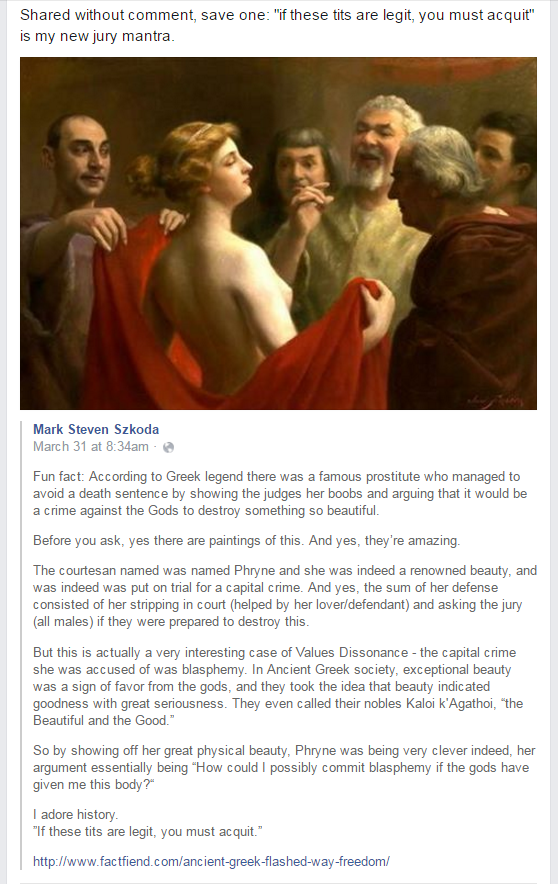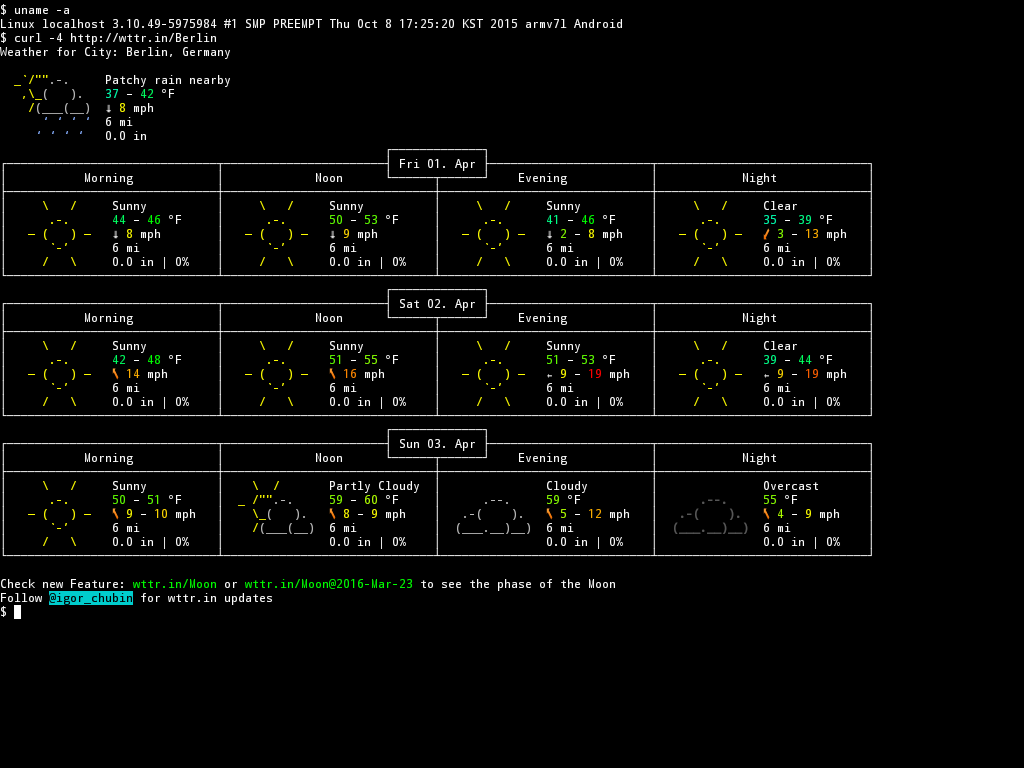
Originally shared by sandria (sannekke)

Originally shared by sandria (sannekke)

Originally shared by David “not B” A
Pilfered from one of my favourite criminal defense attorneys on Fb…
Suitable musical score: “Tits Legit! Acquit!” by MC Gavel

Originally shared by Edward Morbius
So, yes, http://wttr.in is pretty slick
Weather reports (and moon phases) via curl. No adware, spyware, cookies, or other funny biddness.
Oh yeah: that’s an Android screenshot. Not an SSH session.
Termux is the bee’s knees. Terminal-and-shell environment that just rawks.

Originally shared by galen stone
I am asking all in my circles to please donate if you support Secretary Clinton. Her campaign will accept as little as three dollars. A small price to pay to ensure that Our President’s progress is protected.
If you cannot donate I ask you to please #Reshare and lets do what We can to raise money for Our Candidate!
Originally shared by Daniel Estrada
The minimal organism
Craig Venter and his team at Synthetic Genomics have constructed what they call the “minimal organism”. Named syn3.0, the organism’s DNA consists of just 531 kilobase pairs (Kbp), which codes for the 473 genes that perform the functions it needs to survive. For comparison, your human genome contains about 3.2 billion base pairs (3.2 Gbp), which codes for over 20,000 genes. Syn3.0 is tiny!
Back in 1995, Venter’s team completed the first full-organism genome sequencing in 1995 using M. genitalium, the smallest known organism (at 525 genes). By the late 90s they took on the goal of producing a “minimal organism” that contained only the core set of genes required for a viable organism to survive to replication. They chose to use M. mycoides, an organism with about 1 Mbp of genetic material, but that replicated much faster in the lab and so was easier to study. In 2008, they chemically synthesized M. mycoides from scratch and called it syn1.0, the first synthetic organism. Syn1.0 was almost genetically identical to its natural analog, with only a few special genetic markers inserted by the team.
The next step was to reduce the M. mycoides genome to its most basic gene set. They knew what some genes did, but many genes had unknown functions. So they systematically knocked out genes to see which combinations would result in viable organisms, where “viable” included replicating in a reasonable time for lab work (= within a few hours). Much of the advance is in the techniques they developed to work so carefully with genetic code; part of the trick was to grow segments of code within the genomes of other organisms, and to piece together the parts (eight in total) into a complete organism. They used these techniques to classify each gene in syn1.0 as essential or nonessential. This resulted in syn2.0, an organism with 478 protein coding genes in 576 Kbp that replicated every 92 minutes. It was the first synthetic organism to be smaller than M. genitalium, the smallest known organism.
The viable syn2.0 was used as the backdrop to see just how small the genome can possibly be. Syn3.0 has 5 fewer genes and about 40 Kbps less than syn2.0, and it replicates in about 3 hours. It also has a distinct phenotype from syn1.0 and its natural cousin, and is vulnerable in many ways. For instance, syn3.0 has only the basic machinery for glcolysis and glucose transport, and can’t process any other sugar sources. For an organism in the real world this is a risky assumption, but syn3.0’s scientists take good care of its development. They write:
http://science.sciencemag.org/content/351/6280/aad6253.full
A minimal cell is usually defined as a cell in which all genes are essential. This definition is incomplete, because the genetic requirements for survival, and therefore the minimal genome size, depend on the environment in which the cell is grown. The work described here has been conducted in medium that supplies virtually all the small molecules required for life. A minimal genome determined under such permissive conditions should reveal a core set of environment-independent functions that are necessary and sufficient for life. Under less permissive conditions, we expect that additional genes will be required.
So this minimal organism is not the minimally viable organism in any general sense; this is the minimal genome needed to replicate in a nutrient-rich, competition free environment. This echoes a point Jeremy England made in his (2013) proof of a thermodynamic lower bound on self-replication. England says that there’s a trade off between complexity and durability: the more complex you are, other things equal, the more energy you have to spend to mantain that complexity.
http://www.englandlab.com/uploads/7/8/0/3/7803054/2013jcpsrep.pdf
The less durable or the less organized a self-replicator is, all things being equal, the less metabolic energy it must harvest at minimum in order to achieve a certain growth rate. Thus, in a competition among self-replicators to dominate the population of the future, one strategy for “success” is to be simpler in construction and more prone to spontaneous degradation.
Syn3.0 can get away with hypersimplicity precisely because the environment is so supportive; it trades organizational complexity for environmental specifity. In most evolutionary contexts, this is a bad trade. But genetics labs are special =)
Other highlights from the syn3.0 paper:
– 41% of geneome (195 genes) is devoted to expression of genome information
– 18% (84 genes) code for cell membrane structure and function
– 17% (81 genes) code for cytostolic metabolism
– 7% (34 genes) code for preservation of the genome
– 17% (79 genes) have no assigned functional category.
The ability to invert large sections of DNA in many genomes has demonstrated that overall, gene order is not critical. We showed that fine-scale gene order is also not a major factor in cell survival… Despite extensive reorganization, the resulting cell grew about as fast as syn1.0, as judged by colony size. Thus, the details of genetic organization impinge upon survival in hypercompetitive natural environments, but the finer details are apparently not critical for life.
I’ve recently written a paper titled “The minimal agent” that collects some proposed minimal organisms from artificial intelligence and systems biology that may help put syn3.0 in some philosophical and historical context.
https://www.academia.edu/23709061/The_minimal_agent
And here’s the Science editor’s popular overview of the syn3.0 research:
http://www.sciencemag.org/news/2016/03/synthetic-microbe-lives-less-500-genes
Learn more about Venter’s team here:
https://en.wikipedia.org/wiki/Craig_Venter
Originally shared by YJ O

Originally shared by Daniel Schwabe
Early morning colors at Navajo Point, Grand Canyon
This beautiful morning light highlights the variety of colors and texture of the Grand Canyon.

Exceptional ISS photo…
Originally shared by Pierre Markuse
Earth from Space: Fishing boats near Vietnam
In this image you can see Vietnam and numerous fishing boats with green lighting to attract fish and squid, taken by ESA astronaut Tim Peake (https://goo.gl/4HAAIV) from aboard the International Space Station (ISS).
The bright city at the top of the image is Bangkok in Thailand, the city at the bottom is Cam Ranh in Vietnam.
Tim Peake is aboard the ISS at the moment (Expedition 47, https://goo.gl/G6v4Ns) and is posting pictures from space on his Twitter, follow him here: https://twitter.com/astro_timpeake
Read more about his Principia mission aboard the ISS here:
Image credit: Vietnam and fishing boats ESA/NASA/Tim Peake https://goo.gl/EYHvL8 / Edited by Pierre Markuse
#science #vietnam #thailand #bangkok #iss #principia #internationalspacestation #timpeake #photography #nightphotography
Originally shared by Steve S
“I’m not dead yet!”

Originally shared by ****
No comment.